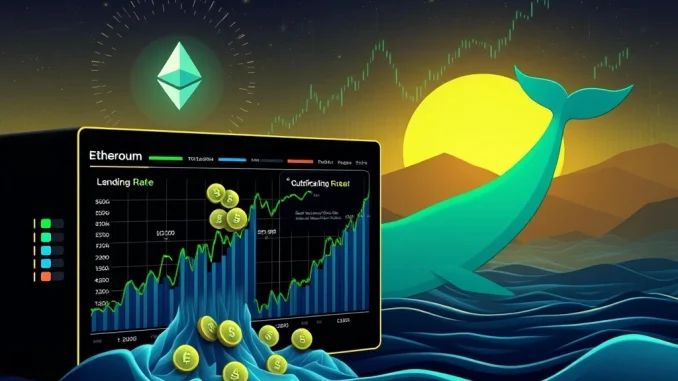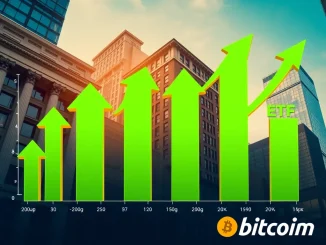
The cryptocurrency world is abuzz following a series of dramatic events centered around Ethereum and the popular decentralized finance (DeFi) protocol, Aave. In a move that sent ripples across the entire crypto market, an astonishing $1.7 billion worth of Ethereum (ETH) was withdrawn from Aave in just one week. This colossal outflow has not only triggered significant market volatility but also dramatically reshaped the lending landscape on the platform, with lending rates skyrocketing.
Understanding the Massive Ethereum Exodus from Aave
Imagine nearly two billion dollars in digital assets suddenly moving. That’s precisely what happened on Aave, a leading DeFi lending protocol. Large investors initiated these sudden outflows, causing immediate and widespread effects. The primary consequence was a surge in borrowing rates on Aave, which climbed above 10%. This sharp increase has destabilized various financial strategies that relied on low-interest loans, particularly those involving ‘looping’ – where investors reinvest borrowed Ethereum to amplify returns.
The data paints a clear picture of the scale:
- Total Withdrawal: $1.7 billion in ETH from Aave within a single week.
- Key Players: Marc Zeller, an Aave developer, pointed to Justin Sun (Tron founder) as a likely orchestrator, with his wallets withdrawing $646 million in ETH. An HTX-affiliated wallet also saw $455 million in outflows.
- Other Contributors: London-based Abraxas Capital Management withdrew $115 million, indicating broader investor caution.
While Justin Sun has not confirmed his involvement, on-chain tracking platforms like Arkham show significant activity from his associated wallets. Despite these large withdrawals, Sun’s accounts still hold a substantial $80 million in ETH on Aave, suggesting a strategic rather than complete exit.
How Aave Lending Rates Skyrocketed: A DeFi Challenge
The fundamental principle of supply and demand dictates lending rates. When a large amount of capital is suddenly withdrawn from a lending pool, the available supply for borrowing decreases. This scarcity, coupled with ongoing demand, naturally pushes up the cost of borrowing. In Aave’s case, the dramatic $1.7 billion withdrawal led to lending rates surging past the 10% mark. This rapid change has profound implications for users:
- Unprofitable Looping: Investors using ‘looping’ strategies, which thrive on low borrowing costs, found their positions quickly becoming unprofitable. This prompted rapid closures and increased unstaking.
- Increased Unstaking: The pressure led to a surge in unstaking activity through liquid staking providers. This has resulted in the Ethereum network’s outflow queue hitting a record high of 627,944 ETH (approximately $2.3 billion) awaiting unstaking.
- Network Strain: Processing this massive volume is estimated to take around 11 days, reflecting considerable strain on the network’s capacity and potentially slowing down other transactions.
The Ethereum Network’s Unstaking Queue: A Sign of Strain?
The record-high unstaking queue for Ethereum, now holding over 627,000 ETH, is a direct consequence of the Aave withdrawals and subsequent position closures. This queue indicates that a significant amount of staked ETH is now being prepared to re-enter the liquid market. While it reflects a response to immediate market conditions, it also highlights the network’s capacity limits when faced with large, synchronized movements. This isn’t necessarily a sign of a fundamental flaw in DeFi, but rather a real-world test of its scalability and responsiveness during periods of high activity.
Whale Play and Crypto Market Dynamics: What’s Next?
The actions of large holders, often referred to as ‘whales,’ are always a critical barometer for the crypto market. Justin Sun’s alleged involvement, though unconfirmed, exemplifies how a few influential entities can significantly impact market dynamics. Another notable whale offloaded 8,005 ETH (worth $30.03 million) at $3,751 per token, indicating strategic profit-taking amidst a bullish market phase. This activity aligns with Ethereum’s 2025 rally, driven by institutional inflows and ETF demand.
While such movements can amplify short-term volatility, analysts generally caution against interpreting them as a signal for a broader downturn. Instead, they emphasize that whale behavior—including erratic deposits and withdrawals—remains a key indicator, especially as Ethereum approaches upcoming network upgrades. The current withdrawals coincide with Ethereum’s impressive 25% weekly price surge, fueled by speculative buying and ETF-related optimism. However, without direct confirmation from Sun or other large holders, the true motivations behind these significant movements remain a subject of intense speculation.
Navigating Volatility: Insights for Ethereum Investors
The recent events highlight the inherent volatility and interconnectedness within the DeFi ecosystem and the broader crypto market. For investors, understanding these dynamics is crucial. While large withdrawals can cause temporary spikes in lending rates and create short-term market turbulence, they don’t always signal a long-term bearish trend. Instead, they often reflect strategic repositioning by large players seeking to optimize returns or manage risk.
Key Takeaways for Investors:
- Monitor On-Chain Data: Platforms that track whale movements and protocol activity can provide early insights into potential market shifts.
- Understand Protocol Risks: Be aware of how sudden liquidity changes can impact borrowing and lending rates on DeFi platforms.
- Diversify Strategies: Relying solely on highly leveraged ‘looping’ strategies can expose investors to significant risk during volatile periods.
- Stay Informed on Network Upgrades: Upcoming Ethereum upgrades could influence market sentiment and network capacity.
Ultimately, the recent Aave withdrawals serve as a powerful reminder of the dynamic nature of decentralized finance. While they presented immediate challenges, they also underscored the transparency of on-chain data and the resilience of the Ethereum network to handle significant capital movements. Continuous monitoring of these patterns will be key to understanding whether these withdrawals represent a temporary market adjustment or a more strategic shift in investor behavior.
Frequently Asked Questions (FAQs)
What caused the sudden surge in Aave lending rates?
The surge in Aave lending rates was primarily caused by the withdrawal of $1.7 billion worth of Ethereum (ETH) from the platform within a single week. This massive outflow reduced the available supply of ETH for lending, driving up borrowing costs due to increased scarcity.
Who is suspected to be behind the large Ethereum withdrawals?
Aave developer Marc Zeller cited Justin Sun, the founder of Tron, as the likely orchestrator of a significant portion of the withdrawals. While Sun has not confirmed his involvement, on-chain data shows substantial ETH movements from his associated wallets, alongside withdrawals from HTX-affiliated and other institutional wallets.
What is the ‘looping’ strategy and how was it affected?
‘Looping’ is a DeFi strategy where investors repeatedly borrow and reinvest an asset (like Ethereum) on a platform to amplify their returns. When Aave’s lending rates surged above 10%, these strategies became unprofitable, forcing investors to rapidly close their positions and unstake their ETH.
What does the record-high Ethereum unstaking queue signify?
The record-high Ethereum unstaking queue, with over 627,000 ETH awaiting unstaking, signifies the immediate impact of the Aave withdrawals and subsequent position closures. It reflects a large volume of staked ETH being prepared to re-enter the liquid market, putting temporary strain on the network’s processing capacity.
How do these withdrawals relate to Ethereum’s recent price surge?
The withdrawals coincide with Ethereum’s recent 25% weekly price surge, which has been attributed to factors like institutional inflows and optimism surrounding Ethereum ETF demand. While the withdrawals caused localized volatility on Aave, the broader Ethereum price rally suggests a strong underlying bullish sentiment in the crypto market, despite these large movements.



